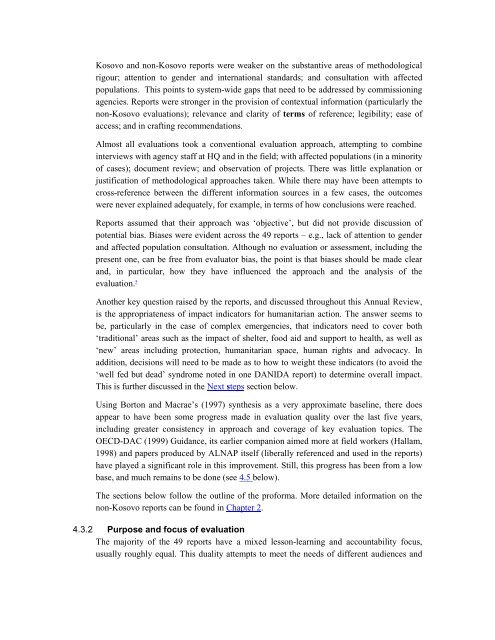Download PDF - ReliefWeb
Download PDF - ReliefWeb
Download PDF - ReliefWeb
You also want an ePaper? Increase the reach of your titles
YUMPU automatically turns print PDFs into web optimized ePapers that Google loves.
Kosovo and non-Kosovo reports were weaker on the substantive areas of methodological<br />
rigour; attention to gender and international standards; and consultation with affected<br />
populations. This points to system-wide gaps that need to be addressed by commissioning<br />
agencies. Reports were stronger in the provision of contextual information (particularly the<br />
non-Kosovo evaluations); relevance and clarity of terms of reference; legibility; ease of<br />
access; and in crafting recommendations.<br />
Almost all evaluations took a conventional evaluation approach, attempting to combine<br />
interviews with agency staff at HQ and in the field; with affected populations (in a minority<br />
of cases); document review; and observation of projects. There was little explanation or<br />
justification of methodological approaches taken. While there may have been attempts to<br />
cross-reference between the different information sources in a few cases, the outcomes<br />
were never explained adequately, for example, in terms of how conclusions were reached.<br />
Reports assumed that their approach was ‘objective’, but did not provide discussion of<br />
potential bias. Biases were evident across the 49 reports – e.g., lack of attention to gender<br />
and affected population consultation. Although no evaluation or assessment, including the<br />
present one, can be free from evaluator bias, the point is that biases should be made clear<br />
and, in particular, how they have influenced the approach and the analysis of the<br />
evaluation. 5<br />
Another key question raised by the reports, and discussed throughout this Annual Review,<br />
is the appropriateness of impact indicators for humanitarian action. The answer seems to<br />
be, particularly in the case of complex emergencies, that indicators need to cover both<br />
‘traditional’ areas such as the impact of shelter, food aid and support to health, as well as<br />
‘new’ areas including protection, humanitarian space, human rights and advocacy. In<br />
addition, decisions will need to be made as to how to weight these indicators (to avoid the<br />
‘well fed but dead’ syndrome noted in one DANIDA report) to determine overall impact.<br />
This is further discussed in the Next steps section below.<br />
Using Borton and Macrae’s (1997) synthesis as a very approximate baseline, there does<br />
appear to have been some progress made in evaluation quality over the last five years,<br />
including greater consistency in approach and coverage of key evaluation topics. The<br />
OECD-DAC (1999) Guidance, its earlier companion aimed more at field workers (Hallam,<br />
1998) and papers produced by ALNAP itself (liberally referenced and used in the reports)<br />
have played a significant role in this improvement. Still, this progress has been from a low<br />
base, and much remains to be done (see 4.5 below).<br />
The sections below follow the outline of the proforma. More detailed information on the<br />
non-Kosovo reports can be found in Chapter 2.<br />
4.3.2 Purpose and focus of evaluation<br />
The majority of the 49 reports have a mixed lesson-learning and accountability focus,<br />
usually roughly equal. This duality attempts to meet the needs of different audiences and
















![CynefinFramework final [Read-Only]](https://img.yumpu.com/19017304/1/190x135/cynefinframework-final-read-only.jpg?quality=85)